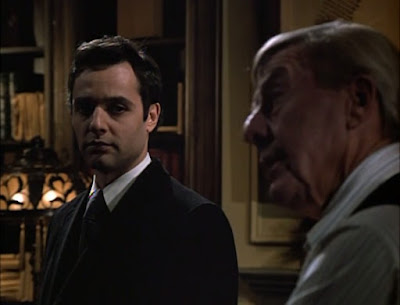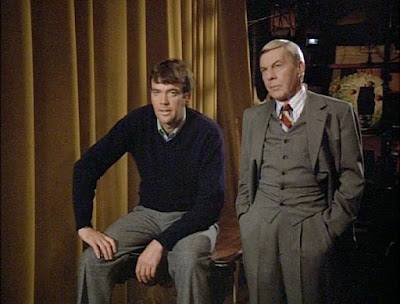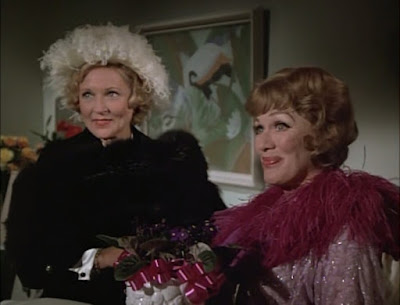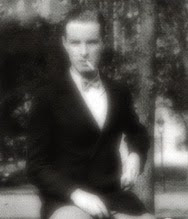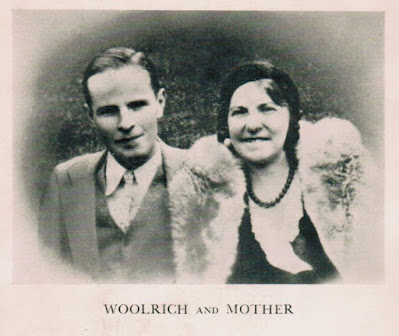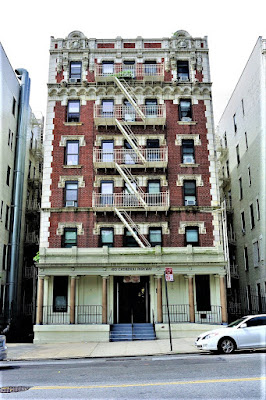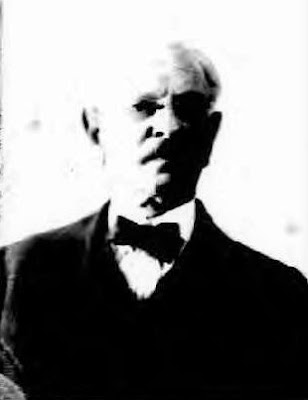I like the way you're not spruce
I like the way you deduce....
--from Ell'ry Q, written on the spur of the moment by The Passing Tramp (apologies to Dale Hawkins and Creedence Clearwater Revival)
 |
| Would you trust these people? Ellery questions the "bereaved widow" (Diana Muldaur) and her fetching boyfriend (George Maharis) The Adventure of the Judas Tree |
Well, last time I was wondering whether, with the very good episode The Adventure of the Wary Witness, there was going to be a permanent shift in tone with the Ellery Queen series, or what little remained of it anyway (just seven episodes).
One thing that does seem to have changed for good is that Ellery is less of a lovable, absent-minded goof and more of a sober investigator. For example, in the first of this batch of three episodes (16-18), The Adventure of the Judas Tree--concerning the death of a wealthy businessman with Chinese connections who is found hanging outside his mansion--there's a comic sequence about Ellery trying to fix the sink, but otherwise "Junior" performs as a dogged and determined crime investigator in this one.
In Judas Tree there's still a serious tone as well---indeed, it's something of a sour, curdled one, actually. There's no one here really to like, or empathize with on any level; and the characters really are not that memorable, by and large, even with a cast including the great film veteran Dana Andrews and accomplished actors Clu Gulager, George Maharis, Diana Muldaur and James Shigeta. For me it made for rather a dull episode, one which would probably be more entertaining on paper.
Dana Andrews, 76 at the time, seems worn out and rather wasted in the part of the dead man's lawyer. Diana Muldaur and James Maharis play an unlikable couple, the dead man's wife and doctor, who were fooling around before his demise, but claim he was just fine with that. James Shigeta plays an enigmatic "Oriental," as they still said back in those days, but does so in a decidedly non-stereotypical manner, happily.
To me westerns actor Clu Gulager (how could he not be a star with that name) actually had the most interesting role, as a reserved Catholic priest heading a Chinese mission. (Surely this episode owes something to a certain EQ detective novel from the 1930s?)
The plot gambit is a classic one, but since it was uninvolving to me I was mostly left stargazing, as it were. I was familiar with all these faces, though the most so with regal Diana Muldaur, who later in her career co-starred in LA Law and Star Trek: The Next Generation; but she went back on television all the way to 1963 with The Doctors and appeared twice on the original Star Trek, as any Trekkie will know.
 |
| Getting their kicks (apologies to Nat King Cole) George Maharis and Martin Milner |
George Maharis made his name young, on the TV buddy road drama series Route 66, where he was paired with the late Martin Milner. This series really seems to have made an impact on kids at the time, though it's all Greek to me, as it were, having never seen it. Maharis left that series at the height of its popularity (his replacement was former physique model Glenn Corbett) and started a short-lived singing and film career. Sadly both fizzled after he was arrested for "lewd conduct" with another man in 1967.
This happened again in 1974, prompting the TV series Arrested Development cruelly to turn him (along with the late singer George Michael) into a punchline many years later. He also made a place in sexual history when, like the late Burt Reynolds, he became one of the first male celebrities to pose in Playgirl. More on him here (plus an episode of Route 66).
A lot of young girls has crushes on Maharis back then, evidently, but as the line in the TV adaptation of Death on the Nile goes, they were "barking up the wrong tree." He was one of those men who was "a little too handsome" as they say in Mignon Eberhart mysteries, hint, hint.
IMDB tells us that Maharis is a lifelong Republican who supported George W. Bush for president in 2004, even as the GOP actively opposed legalizing gay marriage that year. Maharis, 93, apparently has never married. I was surprised to find out that he played the wicked sorcerer in the 1982 fantasy cheese fest The Sword and the Sorcerer, which I recall seeing (and being hugely disappointed in) at the movie theater at the time. I guess he let a little of his freak flag fly there. There was lots of both cheesecake and beefcake in that film as I recollect.
By the way, Clu Gulager, also 93, is still with us too, as is Diana Muldaur, though she retired from acting long ago. Gulager appeared as recently in 2019 in the Oscar-winning Once upon a Time...in Hollywood.
*******
 |
| Ellery--whoops, Mallory--is about to get whacked! Troy Donahue in The Adventure of the Sinister Scenario |
The next episode, The Adventure of the Sinister Scenario, is more of a throwback to the lighter EQ style and I think it's a triumph; indeed, it's one of my favorites in the series.
Here Ellery and his Dad are out in Hollywood, where a film--evidently a "Poverty Row" number--is being made from one of his detective novels.
Former teen heartthrob Troy Donahue, a blond and blue-eyed vet of sudsers like Imitation of Life and A Summer Place, portrays Gilbert Mallory, the actor who plays Ellery in the film. (This is a very meta episode!)
Mallory's, well, a total asshole, really, and in his five or so minutes in the episode he manages to alienate everyone around him, including not only the Queens, but also leading lady Pamela Courtney (Susan Damante), his estranged wife Claire Mallory (Barbara Rush, appearing in the series again, in a much more glamorous role), co-star Lionel Briggs (Noah Beery, Jr.), who plays Inspector Queen, director Michael Raynor (Vincent Price), publicist Dave Pierce (Don Defore) and stuntman Mike Hewitt (James Sikking).
Soon Mallory lies dead on the set, taken out by real gunshots from a prop gun fired by Pamela Courtney. Of course this is a classic murder gambit in mysteries and it plays out beautifully here. (Creepily it also recalls the recent real life fatal shooting by actor Alec Baldwin of cinematographer Halyna Hutchins on the set of the film Rust.)
The plot is tricky and very nicely clued, plus there's lot of knowing satire of Hollywood and filmmaking. Noah Beery as the supporting actor worried about the continued cutting of his lines is especially appealing here. Beery, whose career went back to old Hollywood days, became known in the Seventies as Jim Rockford's Dad Rocky on The Rockford Files, making his casting as Ellery's movie Dad especially apt. (He and David Wayne both were short of stature.) There's also a cameo as an LA police captain from old time Western actor Paul Fix, who co-starred with Beery in the great Western Red River, a nice touch.
Famous television Dad (Ozzie and Harriet, Hazel) Don Defore has something of the Jim Backus role from The Mad Tea Party, though he is given more to do. Susan Damante is quite snootily amusing as the aspiring serious actress who hates slumming in a B mystery film. Troy Donahue, who to me always came off like something of a sulky pretty boy, leans hard on that quality to come off as convincingly unlikable. Carole Cook, a Texas-born protégé of Lucille Ball who is still around today at age 98, has a great small role as Louella Parsonish gossip columnist. By comparison, Vincent Price's part is actually a bit dull, though he's fine in it. James Sikking doesn't get a lot of lines, but if you liked him on the Eighties cop drama Hill Street Blues, you will get a kick out of seeing him here. He was a very good actor.
I also loved how this episode made a virtue of the show's cheap sets by turning those cheap sets into the film sets, as it were, in another meta moment. When the camera pans back from the set of the EQ "film" and we realize we are seeing, in its entirety, the set of the Queens' brownstone interior on the actual TV series, it's quite neat. I do love that brownstone set. It may not be the glam brownstone from Tim Hutton's Nero Wolfe series a quarter century, which was filmed in real buildings, but it has nostalgic, gimcrack charm for me.
In this episode there's good humor too, not forced, with Ellery and his Dad, who hates the actor cast to play him and would rather prowl the streets of Hollywood looking for stars. Of course in real life David Wayne got to act with many of the greats, like Katherine Hepburn, Spencer Tracy, Marilyn Monroe, Joseph Cotten, Jennifer Jones, Ethel Barrymore, Susan Hayward, Thelma Ritter, Monty Wooley, Constance Bennett, Ann Sheridan, Victor Mature, Betty Grable, Charles Laughton, Frank Sinatra, Debbie Reynolds, Mitzi Gaynor, etc.
Wayne was a terrific actor who never got his due on film. He had a brilliant stage career, winning two Tonys, but he was never nominated for an Oscar and only ever received a single Emmy nomination, for an interesting sounding suspense anthology series, Suspicion. To a lot of people around my age he's probably best remembered for his four appearances as the Mad Hatter in Batman or perhaps his four appearances as Digger Barnes in Dallas. Or maybe as Col. Clydesdale in the live action Disney film The Apple Dumpling Gang.
He was a terrific actor, to be sure, in light comedies like Adam's Rib with Hepburn and Tracy, but he was also a fine dramatic actor. See, for example, the 1951 American remake of the film M, where he ably takes on Peter Lorre's original role as a serial murderer of children, based on the infamous real-life Vampire of Dusseldorf. He's a long way off from Inspector Queen here!
*******
 |
| Lillian McGraw (Dr. Joyce Brothers) discusses the art auction with her husband Clint (Forrest Tucker) as Simon Brimmer snoops on The Adventure of the Two-Faced Woman |
The next episode, The Adventure of the Two-Faced Woman, is pretty good, although I felt like it got a bit convoluted at times. It's an art mystery, concerning the murder of a woman who just bought two paintings at an auction, one by a long dead Dutch master and the other by a modern artist named Vargo, who is very much alive.
The victim is played by the late Dr. Joyce Brothers, a woman who became this odd sort of Seventies celebrity. Back in the Fifties, when she was "just" a housewife, she won $64,000 on the game show The $64,000 Dollar Question (the category was boxing--how cute!), then earned a degree in psychology, adding "Dr." to her name.
Somehow Dr. Brothers started popping up all the time on television in the Seventies, sometimes as herself, sometimes, like here, in acting roles. I suppose she was the Dr. Ruth of her day, if you remember 90s celebrity sex therapist Dr. Ruth.
There's also Vera Miles, the late Theodore Bikel (very hammy) and Victor Buono (wasted in a cameo). Plus the return of Simon Brimmer! I enjoyed this episode and every mystery series needs at least one art mystery, to be sure, but this one's not in the top tier. There is one very cute visual clue though!
Well, it's almost time to say goodbye to the EQ TV series, sniff! Happily, as I recall it the last four episodes were pretty good, with at least one of them being a true TV mystery classic.



